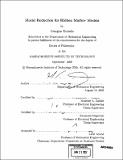Model reduction for Hidden Markov models
Author(s)
Kotsalis, Georgios
DownloadFull printable version (1.924Mb)
Other Contributors
Massachusetts Institute of Technology. Dept. of Mechanical Engineering.
Advisor
Munther A. Dahleh and Alexandre Megretski.
Terms of use
Metadata
Show full item recordAbstract
The contribution of this thesis is the development of tractable computational methods for reducing the complexity of two classes of dynamical systems, finite alphabet Hidden Markov Models and Jump Linear Systems with finite parameter space. The reduction algorithms employ convex optimization and numerical linear algebra tools and do not pose any structural requirements on the systems at hand. In the Jump Linear Systems case, a distance metric based on randomization of the parametric input is introduced. The main point of the reduction algorithm lies in the formulation of two dissipation inequalities, which in conjunction with a suitably defined storage function enable the derivation of low complexity models, whose fidelity is controlled by a guaranteed upper bound on the stochastic L2 gain of the approximation error. The developed reduction procedure can be interpreted as an extension of the balanced truncation method to the broader class of Jump Linear Systems. In the Hidden Markov Model case, Hidden Markov Models are identified with appropriate Jump Linear Systems that satisfy certain constraints on the coefficients of the linear transformation. This correspondence enables the development of a two step reduction procedure. (cont.) In the first step, the image of the high dimensional Hidden Markov Model in the space of Jump Linear Systems is simplified by means of the aforementioned balanced truncation method. Subsequently, in the second step, the constraints that reflect the Hidden Markov Model structure are imposed by solving a low dimensional non convex optimization problem. Numerical simulation results provide evidence that the proposed algorithm computes accurate reduced order Hidden Markov Models, while achieving a compression of the state space by orders of magnitude.
Description
Thesis (Ph. D.)--Massachusetts Institute of Technology, Dept. of Mechanical Engineering, 2006. Includes bibliographical references (leaves 57-60).
Date issued
2006Department
Massachusetts Institute of Technology. Department of Mechanical EngineeringPublisher
Massachusetts Institute of Technology
Keywords
Mechanical Engineering.